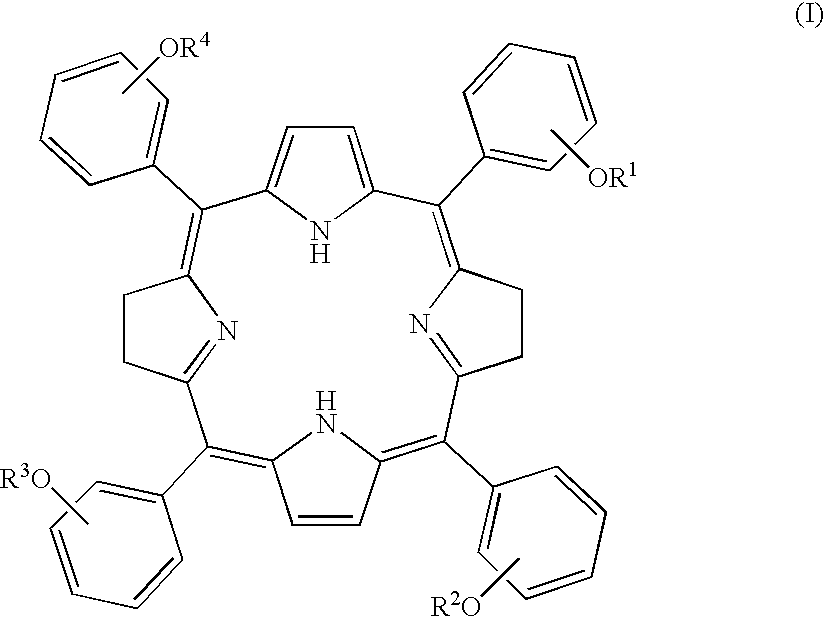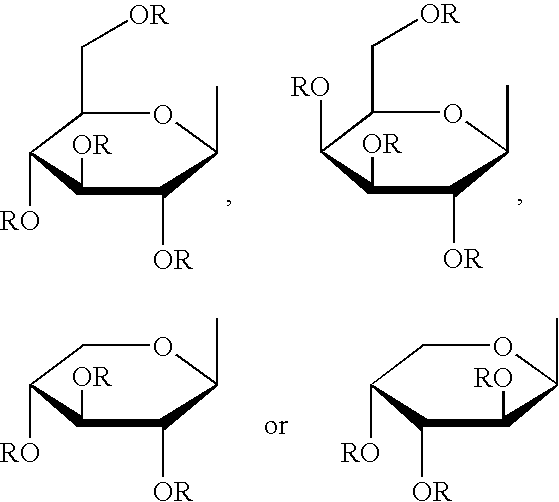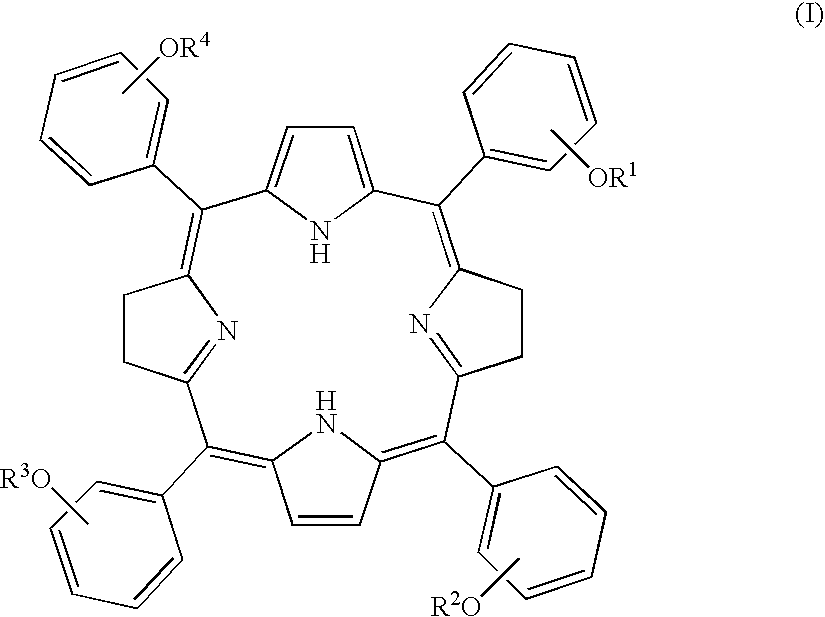Tetraphenylbacteriochlorin derivatives and compositions containing the same
- Summary
- Abstract
- Description
- Claims
- Application Information
AI Technical Summary
Benefits of technology
Problems solved by technology
Method used
Image
Examples
production example 2
3-(2',3',4',6'-tetra-O-acetyl-.beta.-D-glucopyranosyloxy)-benzaldehyde
[0109] Quinoline (15 mL) was added to 1.5 g (12 mmol) of m-hydroxybenzaldehyde, to which 2,3,4,6-tetra-O-acetyl-.alpha.-D-glucopyr-anosyl bromide (10.1 g, 25 mmol) was added. Immediately after that, 5.8 g (25 mmol) of silver (I) oxide was added, followed by 15 minutes' stirring at room temperature. The resulting mixture generated heat with progress of reaction. Because the resulting mixture became more and more viscous during the reaction, the mixture was stirred with a glass rod as required. A 25% acetic acid (100 mL) was added to the reaction mixture, which was well stirred on ice bath, followed by filtration. Methanol (150 mL) was added to the filtered-out residue, followed by heating. Then, the resulting mixture was filtered and the obtained filtrate was concentrated until crystals separated. The resulting residue was recrystallized from hot methanol to give the title compound. Light yellow acicular crystals. ...
production example 3
5,10,15,20-tetrakis[3-(2',3',4',6'-tetra-O-acetyl-.beta.-D-glucopyranosyl--oxy)phenyl]porphyrin
[0111] 3-(2',3',4',6'-tetra-O-acetyl-.beta.-D-glucopyranosyloxy)benzaldehy-de (1.9 g, 3.8 mmol) was dissolved in 680 mL of dry chloroform in an argon-replaced 500 mL round bottom flask equipped with a conderser tube. A reaction vessel was shielded from light with aluminum foil, 0.27 mL (0.27 g, 3.8 mmol) of pyrrole were added through a syringe, and argon gas was introduced with stirring. After about 30 minutes, the introduction of the gas was stopped and BF.sub.3.Et.sub.2O (0.10 mL, 0.80 mmol) was added to the reaction mixture using a syringe, followed by 10 minutes' argon replacement. After an hour, zinc acetate dihydrate (3.9 g, 17.5 mmol) was added to the reaction mixture and argon replacement was carried out for 10 minutes. The resulting mixture was stirred at room temperature for 20 to 24 hours. Subsequently, p-chloranil (0.70 g, 2.7 mmol) was added to the reaction mixture at a time a...
production example 4
3-(2',3',4',6'-tetra-O-acetyl-.alpha.-D-galactopyranosyloxy) benzaldehyde
[0113] m-Hydroxybenzaldehyde (1.5 g, 12 mmol), dichloromethane (14 mL), a 5% aqueous solution of sodium hydroxide (20 mL) were put in a 100 mL round bottom flask and stirred vigorously. At that time, a water phase turned yellow. Into the resulting mixture, tetra-butylammonium bromide (0.66 g, 2.0 mmol) was added and then a solution of acetobromogalactose (3.6 g, 8.6 mmol) in dichloromethane (about 6 mL) was added dropwise. A reaction vessel was shielded from light and the resulting mixture was stirred vigorously for 2 days at room temperature. A separated organic phase was washed with a 5% aqueous solution of sodium hydroxide (20 mL.times.3) and then with water (20 mL.times.3), dried over anhydrous sodium sulfate and evaporated to dryness to give the title compound. Light brown solid. Yield 2.2 g, 39%. The product was unstable at room temperature, and stored in a freezer.
[0114] .sup.1H NMR (300.07 MHz, CDCl.sub...
PUM
| Property | Measurement | Unit |
|---|---|---|
| Hydrophilicity | aaaaa | aaaaa |
| Selectivity | aaaaa | aaaaa |
| Molar extinction coefficient | aaaaa | aaaaa |
Abstract
Description
Claims
Application Information
 Login to View More
Login to View More - R&D
- Intellectual Property
- Life Sciences
- Materials
- Tech Scout
- Unparalleled Data Quality
- Higher Quality Content
- 60% Fewer Hallucinations
Browse by: Latest US Patents, China's latest patents, Technical Efficacy Thesaurus, Application Domain, Technology Topic, Popular Technical Reports.
© 2025 PatSnap. All rights reserved.Legal|Privacy policy|Modern Slavery Act Transparency Statement|Sitemap|About US| Contact US: help@patsnap.com



